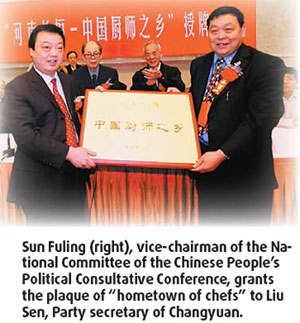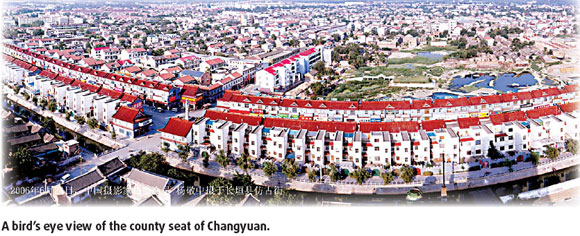Located in the hinterland of Henan province, the past and present of Changyuan County are representative of experiences shared by much of the rest of the country.
Boasting a history of 5,000 years, this is a county where Confucius once taught and his disciples administered. It also produced seven ministers during the cultural flourishing of the Ming Dynasty (1368-1644AD).
Changyuan today has developed into a 1,051 sq km county with 800,000 residents in its 14 townships, striving to correspond to the State's shifting emphasis on midland development. A core site of city groups in both the Central Plains and neighboring Shandong Province, the county is a nationally celebrated hometown for chefs and hoist machinery, as well as a major base for the construction industry and medical equipment production.

The county is home to 4 of the 41 national master chefs and 16 of the 33 top cooks provincially. It has been christened the "hometown of cooking" by the China world cuisine federation in 1999 and "hometown of chefs" by the nation's cuisine association four years later. Changyuan's three cooking schools train over 600 professionals a year and have contributed more than 150,000 people to the catering industry, 6,500 of whom are at least third-class chefs. As many as 230,000 professional chefs from Changyuan are working across the country, with more than 200 working overseas.
Hoist machinery has also long been key in Changyuan's development. As many as 853 local enterprises produce complete machines, and 800 manufacture spare parts, with products classified into 10 varieties with 200 specifications. Twenty-six enterprises in the county are ISO9000 and ISO9002 certified. What's more, because Changyuan-produced machinery with a carrying capacity of below 50 tons accounts for 70 percent of the domestic market, it is said that if the county stopped producing hoist machinery, Chinese construction would immediately feel the strain.
The local anticorrosion industry, meanwhile, has gone through a process of rapid development. Currently, there are 14 State-level anticorrosion enterprises, of which 11 have passed ISO9002 certifications. Apart from domestic market, the companies also serve customers in more than 10 overseas markets including Germany, Qatar and Iraq.
In addition, Changyuan has become China's largest production base for medical equipment with 58 companies in the field, employing more than 30,000 people and producing some 30 series and 600 varieties of equipment. The county draws close to 2 billion yuan ($266 million) in annual sales from the medical sector alone.
In the 10th Five-Year-Plan (2001-2005), Changyuan had accumulated a total investment of 1 billion yuan ($133 million) in basic infrastructure. In particular, 80 km of expressways, 43 km of urban roads and 151 km of county and township roads were built and renovated, and 73 percent of the countryside was covered with asphalt roads, up 22 percent from the previous five years.
Furthermore, the completed downtown area reached 20 sq km, with an urban population of 260,000, over 107,000 of whom were previously rural residents. Overall, the local urbanization rate reached 32 percent, 13.5 percent more than the 9th Five-Year-Plan (1996-2000).
There are two water plants in the county, with sources originating from both the Yellow River and underground aquifers. Their daily water supply capacities are 50,000 and 5,000 tons, respectively. Changyuan's electric power, meanwhile, comes from Central China's electricity network and the county's own 13 kilovolt power stations, 13 kilovolt transformer substations, and two 35 kv transformer substations.
By 2010, Changyuan expects to have a GDP of 12.7 billion yuan ($1.7 billion), fixed asset investment of 8.3 billion yuan ($1.1 billion), local fiscal income of 500 million yuan ($66.6 million), and an urban per capita disposable income of 10,000 yuan ($1,333) and a 45 percent urbanization rate with 300,000 urban residents.

(China Daily 10/19/2007 page26)
